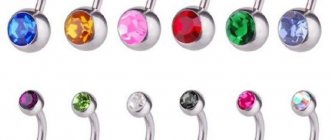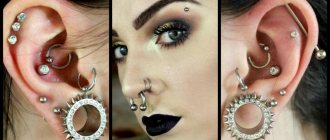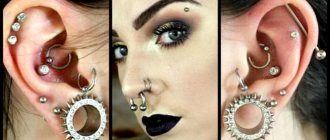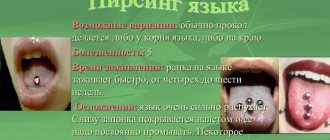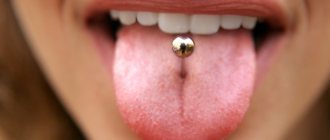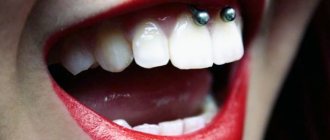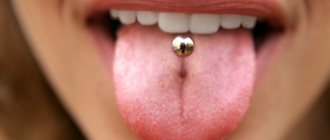Piercing is a fairly common procedure. She no longer causes strong bewilderment and ugly thoughts among those around her. But people still have disputes and misconceptions when they hear about piercing of the nipples or genitals, as well as the tongue. Many people do tongue piercing these days. The reasons for this are varied. But before you make an important decision and come to a specialist to pierce your tongue, you need to determine whether this operation is necessary and whether it has contraindications.
The history of piercing
For the first time, residents of African tribes and Polynesia began to practice the procedure of piercing various parts of the body. The Maasai were the first to introduce various decorations into their ears and lips. At that time, it was believed that the larger the size of the jewelry in the body, the greater the “weight” a person had in the tribe.
Navel piercing first appeared in Egypt. Women loved this procedure very much. The presence of a hole in the navel area of the Egyptian woman indicated that she belonged to “high society.”
In Tsarist Russia, sailors preferred to pierce their earlobes and wear voluminous earrings. Such a “symbol” meant that the person crossed the equator or belonged to the Cossack family. Later, starting in the 80s, it became fashionable for rappers to pierce their earlobes.
Nose piercing first appeared in India. The presence of a septum piercing (a puncture of the nasal septum) in a woman indicated her marital status, that is, that the girl was married.
Nipple piercings were done by warriors of Ancient Rome. An earring in a man's nipple indicated his masculinity, courage and determination. Only the strongest and bravest warriors had the right to have nipple piercings. Those with nipple earrings regularly competed in strength and courage. In order not to damage the “decoration”, special fabric capes were worn over the earrings.
The ancient Aztecs and North American tribes first began piercing their tongues. They carried out the procedure consciously, since it was considered a magical rite that helped to reunite with the Gods. The protruding blood on the tongue was considered sacred; it served as a means of calming the Spirits.
These days, piercings have completely different purposes. By piercing various parts of the body, people want to show their individuality, attract attention or stand out. For some, piercing is a way to feel new emotions, to prove to themselves that they can overcome pain and, as it were, move to a “new level of development.”
Tongue piercing procedure
Tongue piercing is a surgical procedure. Although it is short-lived, it can be very dangerous to health, and in certain cases, to life. The procedure is a sharp puncture of the soft mucous membrane of the tongue with the further introduction of a special earring or barbell.
Among the huge variety of “decorations”, the most common are vertical rods cast from medical titanium or steel. In appearance, the earring turns out to be double, that is, it can be seen both from above and, if you lift your tongue, from below.
Another popular type of piercing is the frenulum. This procedure for introducing a frenulum into the tongue is less painless; during the operation, the client releases less blood, and, accordingly, healing of the wound surface occurs much faster.
Other "decorations":
- rings;
- carnations;
- staples.
How to Identify and Treat a Tongue Piercing Infection
How infections develop
Infection occurs when bacteria gets inside the piercing. Tongue piercings—especially new ones—are more prone to infection than other piercings due to all the bacteria in the mouth. Most bacteria enter the body through food and drink. French kissing, oral sex, and other types of sexual activity can also carry bacteria.
Keep reading to learn how to identify an infection, relieve symptoms, and prevent further complications. Beauty salon enlarge individual parts of the tattoo.
How to identify an infection
If the piercing is new, irritation is normal.
During the first two weeks you may experience:
- Redness.
- Slight swelling.
- Light pulsation.
- Mild heat or warmth.
- Clear or white discharge.
Redness or swelling that extends beyond the piercing may be a sign of infection.
Other early signs of infection:
- Unpleasant swelling.
- Lasting warmth.
- Strong pain.
- Excessive bleeding.
- Pus or yellow discharge.
- A bump on the front or back of the piercing.
- Heat.
Mild infections can usually be treated at home. But if your symptoms are severe or if you are experiencing the infection for the first time. You should have your piercing examined immediately.
Purpose of piercing
People who decide to have their tongue pierced have different goals. It is widely believed that the presence of an earring in the soft tissue of the tongue improves sexual satisfaction in a partner. Young girls often decide to have their tongue pierced simply to become fashionable. Some people pierce a part of their body in order to show others that they belong to a certain subculture.
Tongue piercing helps people stand out “among the crowd,” to indicate that they are not like everyone else, and to prove their own uniqueness and individuality.
What decorations can be used
The most popular options for tongue decorations include:
- Classic barbells. This is a straight cylindrical rod with decoration on the tips.
- Curved rods. Resembles the shape of a banana.
- Labrets. These are rods on which there is a disk on one side and a round clamp on the other.
- Rings and earrings. Typically used for insertion into the edges and tip of the tongue.
An important criterion is the material of the decoration. It is better to choose hypoallergenic metals such as gold and silver. A fairly universal and inexpensive solution is jewelry made of nickel-plated steel and brass. Another good alternative is a titanium barbell.
You should avoid tongue bars and earrings made of plastic and wood. Despite the very low price, they can contribute to the development of infectious complications and allergic reactions.
Advantages and disadvantages
The presence of an earring in a person's tongue always attracts everyone's attention to him. The corresponding procedure can be treated both poorly and well. But almost always the presence of a puncture arouses interest among others.
Anyone who agrees to have their tongue pierced feels special, different from everyone else. In this way a person wants to show his individuality. And some people decide to get piercings in order to show their decisive character or, conversely, to overcome themselves.
Pros of a puncture
- After the procedure, a person begins to consider himself liberated, courage and determination appear in his character. Anyone who decides to have their tongue pierced “challenges” a monotonous and boring life.
- Tongue piercing is not as noticeable to others as, for example, eyebrow piercing. If necessary, the “decoration” can be removed, and no one will notice the presence of a puncture.
- Improves sexual sensations for a partner. When kissing or performing oral sex, tongue piercing can add additional sexual arousal and add a sense of exoticism to sexual contact.
- After surgery, a long recovery period is required. At this point, you need to follow a strict diet and give up a large list of foods. This restriction helps some people lose weight.
- If all the basics of proper care are followed, the risk of complications is minimal.
- The ability to remove the “decoration” at any time and ensure that the tongue piercing is healed. Thanks to active regeneration of soft tissues, the puncture heals very quickly.
Flaws
- The procedure is very painful. If a person is very sensitive to pain, then it will be difficult for him to undergo such an operation.
- The recovery period, which can “stretch” for several months, also brings a lot of inconvenience. The healing process of the wound surface provokes pain and physical discomfort. It can take from 3 to 6 months before all the unpleasant sensations end.
- Piercing needs to be done only in a specialized clinic or salon, and always by an experienced and qualified master. Many people pierce various parts of the body at home. But in this option, the risk of developing dangerous complications increases sharply. Saving on your own health can cost much more than the cost of surgery in a trusted clinic.
- There is a risk of infection. This often occurs due to the use of unsterile instruments during surgery. The development of infection is not the worst complication of piercing. Complications include hepatitis and herpes. The likelihood of developing complications dangerous to health increases significantly if the procedure is performed by inexperienced or unqualified professionals.
- Tongue piercing almost always damages teeth. This occurs due to the fact that a person has a desire to “chew” or bite the earring. Teeth begin to deteriorate and break for another reason - while chewing food, an unintentional biting of a metal rod occurs.
- If you have a tongue piercing, careful care of your teeth and gums is required. Many young girls and boys, in order to boast about the presence of “decoration” in their mouth, show it off to others who touch the barbell with their hands. All this causes an increase in the number of bacteria and pathogenic microorganisms in the oral cavity.
- Development of gum disease.
- The presence of a foreign body in the oral cavity often provokes the development of discomfort - redness of the mucous membrane, itching, the desire to scratch the tongue.
Risks
In general, tongue piercing is a fairly safe procedure. The biggest risk it poses is infection of the wound soon after the healing process begins. However, most infections are mild and can be easily treated with oral antibiotics.
However, sometimes people develop severe infections, such as abscesses. In such situations, the person may require hospitalization or intravenous antibiotics.
In addition, piercing is associated with the following risks:
- damage to teeth and gums;
- gum recession on the inside of the mouth;
- Ludwig's tonsillitis is a rare type of skin infection that develops under the tongue.
- Accidental ingestion of jewelry, which may result in choking or throat damage;
- acquiring diseases such as tetanus or HIV if the piercer uses unsterile instruments or jewelry that has already been used before.
- spread of infection to the blood or other organs (rarely observed).
In some cases, the body rejects the piercing, which can lead to further complications.
The degree of pain of the procedure
Any operation is painful. And tongue piercing is no exception. The puncture procedure itself lasts a couple of seconds. The patient feels a sharp, but quite tolerable pain. The main painful sensations begin at the stage of healing of the wound surface. The lining of the tongue is highly sensitive, and since this organ of the body is constantly moving, the pain will be excruciating. The discomfort will continue until the wound heals.
It is possible to reduce the intensity of painful sensations. To do this, you must adhere to the following basics:
- The operation should only be performed in a specialized clinic (salon) by a qualified specialist;
- During the recovery period, constantly care for the wound;
- stop smoking and drinking alcoholic beverages (at least for the recovery period);
- try to talk less in the first days after surgery;
- Avoid eating hot and spicy foods.
Brief historical background
The earliest evidence of tongue piercing comes from the rituals of the Mesoamerican peoples, who used plant spines as tools.
It is known that the procedure was performed to initiate a person into the upper echelons of society and was part of a cult. The indigenous people of Australia considered tongue piercing a means of exorcism and treatment against evil magical influences.
The fashion for this type of piercing came to Europe already devoid of religious significance. In the 1990s. The popularity of body modification began to flourish, and such piercing was demonstrated by many youth idols, music and film stars, making it a symbol of freedom of expression and sexuality. Since then, it has been included in the range of services of most piercers.
Puncture procedure
Tongue piercing is an operation. To avoid complications, it is recommended to carry it out in a specialized salon. Only a qualified doctor can perform the procedure properly. Only a master can determine the optimal place for a puncture, where the risk of injury to nerves and blood vessels will be minimal.
During the operation, sterile instruments and disposable rubber gloves must be used.
Sequencing:
- The oral cavity is treated with an antiseptic. In most cases, patients ask for additional oral anesthesia. Lidocaine solution is used as an anesthetic.
- A special clamp is used to fix the tongue.
- A puncture is made on the tongue fixed with a clamp. The direction of the needle is from bottom to top.
- A metal rod or a “decoration” chosen by the patient is inserted into the resulting hole.
Tongue piercing at home
It is not advisable to do piercing yourself.
To minimize the risk of complications, the following requirements must be met:
- A well-lit place is selected for the operation. There must be a table in the room on which the necessary tools are laid out.
- For the operation, only sterile instruments (clamp, needle, earring) are used.
- The oral cavity must be treated with a disinfectant solution and, if necessary, irrigated with an anesthetic drug.
- For the puncture site, select the part of the tongue located closer to the tip. There are no large blood vessels in this area of the organ.
- The tongue is clamped with forceps.
- A special needle pierces the soft tissue of the organ strictly perpendicular to the surface.
- The bar is threaded. It is recommended to use a catheter to insert the “decoration”.
A catheter is a special device that helps you do piercing at home. Thanks to the catheter, the sensation when piercing the soft tissue of the tongue is less painful.
The catheter is a small needle equipped with a plastic tube. An earring or other “decoration” is inserted into the cavity of the tube. After the puncture, the earring goes into the hole along with the needle. Subsequently, the needle and catheter are removed, and the “decoration” remains in the inner part of the tongue.
Rod selection
A tongue piercing bar is a piercing tool consisting of a metal rod, the average width of which is 1.6 mm, as well as 2 fixing screws. In order to choose the right earring, which will allow you to avoid significant complications and discomfort when wearing, you should know what sizes and materials exist, and also be able to put on the jewelry correctly.
Size
The thickness and length of the metal product is selected based on the individual characteristics and preferences of the client. A standard size bar is a structure 16 mm long and 8 mm wide. The diameter of the wrap, the outer ball or stone, is also taken into account. When using a standard bar, the product does not protrude beyond the upper layers of the tongue. A correctly inserted structure practically does not move out and does not lead to deformation of tissue structures.
Tongue piercing rods
The client can choose any suitable size - from 5 mm to 40 mm, depending on preferences. Experts recommend inserting standard rods into the tongue, which will not cause any inconvenience.
The larger the diameter of the product, the more you will need to stretch the puncture site. Jewelry that is too large is characterized by severe discomfort when worn, so it is more difficult to get used to it. Rings or bars that touch the surface of the teeth can lead to rapid degradation of the enamel.
It is not recommended to use thin rods, as they are more likely to be displaced, which can cause severe stretching of the puncture, in some cases up to the size of the ear tunnel.
Materials
To eliminate possible suppuration or irritation, special attention must be paid to the choice of material. To constantly wear a barbell, experts recommend using gold or silver items, the chemical composition of which will not affect your health in any way.
Cheap metal structures, especially those coated with varnish or paint, will begin to oxidize and crack, which can cause the internal coating to remain inside the pierced area.
It is best to purchase products made of titanium, a material widely used in medical practice. This type of metal is better combined with external human tissues, therefore it does not lead to rejection, is not toxic, and is absolutely harmless to the body.
After direct tissue incision, it is best not to use medical metal, because the chances of developing suppuration in the tongue increase. It is better to use silver or gold inserts while the wound is healing.
Recently, barbells made of silicone, surgical steel and bioplastic have been gaining popularity, each of which has its own advantages and disadvantages. In this case, it is best to consult a specialist.
Designs
Small metal balls of simple shape or shiny rhinestones are best suited for girls. The multi-colored elements resembling thorns look quite interesting.
Curly piercing bars are gaining particular popularity, the images on which can be either brutal - bones, skulls, crosses, or feminine, in the form of hearts, stars or butterflies. Imagination and understanding of one’s own preferences play a big role. Some models are characterized by a special thread, which allows you to alternate different shapes on one rod.
Commonly used types of jewelry:
| Type of decoration | Description, advantages |
| Barbell | It is the most popular and safest option. The product is a straight rod, at the ends of which there are special balls that allow you to better secure the decoration. |
| Banana | A type of barbell that has a curved shape. Like the usual variation, this type of decoration also belongs to the classics. |
| Labret | The same rod, but at one end there is a cast base, and at the other there is a special thread for screwing on additional decoration. The variation is the easiest of all available. |
| Ring | It is an ordinary ring-shaped decoration, at the end of which there is a special ball that fixes the product on the tongue. |
| Barbell and ring | It is the most popular variety in the case of vertical piercing. |
Metal rods are often silver in color, with exceptions being acrylic, gold, and surgical steel, which can be found in black or gray. Cheaper models can come in different shades by adding paint or varnish, but such materials can cause a wide range of complications and discomfort in the tongue.
Many piercing experts point out that when choosing jewelry, it is better to pay attention to the classic barbell, which is characterized by a straight and elongated shape.
How to wear
The barbell is put on immediately after the puncture, which avoids further complications or damage while wearing. After approximately 3-4 weeks, the earring can be replaced with a new element.
Even after the wound has completely healed, during the process of removing or putting it on, it and the entire oral cavity must be treated with a liquid saline solution, and the jewelry itself must be treated with hydrogen peroxide.
The barbell must always be threaded with caution. It is better to do this from the bottom up, which will avoid many complications. In some cases, the earring may include a special clasp to which the balls are attached. This model is quite difficult to remove, so it is best to seek advice and help from a specialist.
If there are any difficulties in the process of putting on or removing the barbell, you should contact a piercer. Otherwise, the puncture site may tear, which significantly increases the risk of developing an inflammatory or purulent process in the mucous tissues of the oral cavity.
Recovery period
The most painful and unpleasant sensations occur during the recovery period. Until the wound surface heals, a person must observe strict restrictions.
On the first day after surgery, the surface of the tongue is very sore and swollen. These changes are normal, pain is the result of soft tissue trauma, and swelling is the cause of damage to lymph flows and blood vessels. The swelling may last for several days.
The wound heals within 2-3 weeks. Complete healing of the wound surface occurs 3-4 months after surgery.
During the first weeks after surgery, you should be careful about your diet. It is important to exclude all spicy, smoked, salty foods from the menu. Dishes should not be hot. It is optimal to eat liquid, fresh, warm food.
Caring for a pierced tongue
The basis of tongue piercing care is the treatment of soft tissues. Every day, twice a day, the wound needs to be treated with antiseptic solutions (Chlorhexidine, a solution of baking soda or potassium permanganate).
For the first 2 weeks after surgery, you need to rinse your mouth after eating. The first days, rinsing is carried out with antiseptic solutions (Chlorhexidine). In the future, you can rinse your mouth with decoctions of medicinal herbs (chamomile, sage, calendula).
Barbell care
For 2 weeks after the tongue piercing, you need to clean the barbell daily with a toothbrush. After this time, it is necessary to regularly remove the “decoration”, thoroughly clean it of surface contaminants and disinfect it in a Chlorhexidine solution.
Possible complications
If the operation was performed poorly, the tongue will be very sore after the piercing. Signs of an inflammatory process (redness, severe swelling, itching) will begin to develop on the surface of the soft tissues. Healing of the wound surface will occur slowly.
Complications after piercing:
- heavy bleeding;
- infection of the wound surface;
- pain while eating, swallowing or communicating.
If negative consequences develop, an emergency visit to the doctor is necessary. Treatment of the inflammatory process consists of treating the wound surface with antibacterial and anti-inflammatory solutions. Your doctor may also prescribe antibacterial injections.
Consequences
The result of poor quality work by the master will be pain and inflammation, prolonged treatment and slow healing. Even if the tongue was pierced in a medical institution, difficulties may arise with subsequent proper care:
- If the procedure was unsuccessful, usually at home, there may be complications: severe bleeding, infection of the wound, inflammation. As a result, long-term treatment with antibiotics is required.
- The swollen tissue will make it painful to chew, speak, and swallow.
- For the first time after the operation, you will have to eat liquid, fresh, non-hot food, so as not to injure the wound and not slow down healing.
- After the operation, special care, rinsing, and cleaning of the rod will be required. Be prepared that after healing, care will also be necessary.
- The diction will change and a slight whisper will appear.
- Since an earring or barbell in the oral cavity is a hard foreign body, it will touch the teeth and damage the enamel. Cracks and chips are constant companions of tongue piercing.
- Partial loss of taste is possible if the nerves have been damaged. Only an experienced surgeon knows the right point so as not to disturb the nerve endings.
- When a piercing is constantly worn, the tissue grows and scars form, which can only be removed surgically.
Contraindications
Piercing is quite popular these days. But tongue piercing is not available to everyone. Before you decide to have surgery and go to the specialist, you need to study the list of contraindications:
- allergy to antibiotics;
- pregnancy period (the risk of infection poses a serious threat to the expectant mother and baby);
- allergy to metals;
- diseases of the nervous system;
- poor blood clotting;
- oral diseases;
- epilepsy;
- some autoimmune diseases (diabetes mellitus, hemophilia).
Tongue piercing is a modern procedure that helps a person stand out among the “crowd.” But before you decide to have a puncture, you need to evaluate all the disadvantages, consequences and dangers of a difficult operation.
Sources used:
- Harden, Blaine. Coming to Grips With the Enduring Appeal of Body Piercing, The New York Times
- A. Stirn (2003): Body piercing: medical consequences and psychological motivations., The Lancet
- Wikipedia material
Keep the rest of your mouth clean
When it comes to tongue piercings, you need to do more than just clean the piercing. You should also keep the rest of your mouth clean.
This will help prevent bacteria from spreading from your mouth and getting inside your piercing.
Dental floss
Flossing helps remove food debris and plaque stuck between your teeth. If not removed, it can lead to bacterial overgrowth and gingivitis. Floss your teeth once a day.
Cleaning
Brushing your teeth twice a day is just as important as flossing. You can also brush your teeth at midday to prevent bacteria buildup. Toothpaste is unlikely to harm your tongue piercing, but be sure to wash it thoroughly.
Rinsing
If you haven't used mouthwash before, there's no need to start now.
If you are using mouthwash as usual, follow the directions for use. Avoid alcohol-based rinses.
